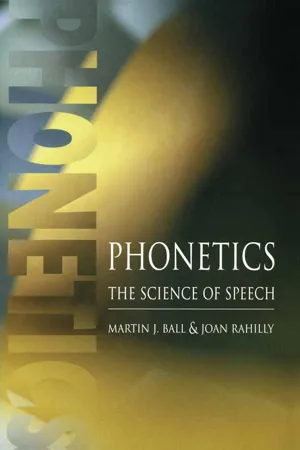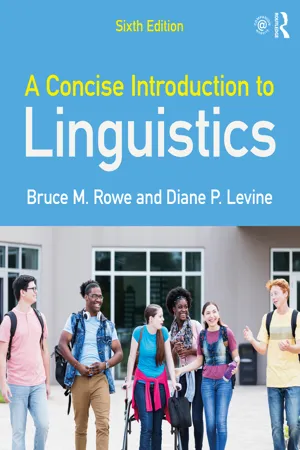Languages & Linguistics
Continuant
A continuant is a sound that can be held for a duration of time without any change in its quality. It is produced by a continuous airflow through the vocal tract. Examples of continuant sounds include fricatives, nasals, and approximants.
Written by Perlego with AI-assistance
3 Key excerpts on "Continuant"
- eBook - ePub
Phonetics
The Science of Speech
- Martin J Ball, Joan Rahilly(Authors)
- 2014(Publication Date)
- Routledge(Publisher)
utterance usage. It is, however, inaccurate, and so no more helpful than the first usage just described. Although it is true that certain sounds traditionally termed consonants do seem to need a short vowel after them (such as [p], [b], [t], [d], and [k]), many others do not. Tr y, for example to say a long ‘s’ sound without adding a vowel at the end. It should sound a bit like a hissing snake, and is quite easy to produce without a vowel. Similarly, a long ‘m’ sound will be like a humming noise and does not require a vowel. Some languages even have words that consist simply of a consonant sound: the sound [v] in Russian is a preposition meaning ‘in’ (written in the Cyrillic alphabet as ʙ).The utterance usage also will be avoided in this book therefore. However, it is an advance in that it moves us away from writing and towards sound as a definition of these terms. Our next two definitions are often found in the phonetics and phonology literature, and are best considered together. We will terms these the ‘phonetic’ and the ‘phonological usage’, and they derive from attempts by speech scientists to define the terms strictly. One such definition looks at how speech sounds are produced. Some speech sounds are articulated with a relatively free flow of air through the mouth, in that the airflow remains smooth and does not become turbulent. Others are made with a narrowing in the oral cavity (produced by movement of the tongue towards the roof of the mouth, for example). In these cases, airflow is likely to become turbulent, or be blocked altogether for a while. In phonetic usage, the sounds with a free passage of air are termed ‘vowels’ and those with a blocked or turbulent airflow are called ‘consonants’.The phonological definition looks at how sounds work in syllables rather than how they are made. All syllables require a nucleus (or central portion) that is sonorant (referring to the sound’s inherent loudness, and roughly meaning clearly perceptible), and optionally beginning and end portions that are less sonorous. Individual languages have different constraints as to whether these beginning and end portions (‘onset’ and ‘coda’) are optional and what precise sounds can go into these three positions. The nucleus position is occupied by vowels, and the onset and coda by consonants under this usage system.These two approaches to defining consonants and vowels overlap in the majority of cases. However, there some instances where they do not. Sounds like [w] in ‘went’ and [j]1 in ‘yes’ are clearly consonants under the phonological usage (they can be onsets but not nuclei in syllables); however, they are produced with a relatively free passage of air and no turbulence and so would appear to be vowels under the phonetic usage. This is reflected in some of the names these sounds are given in phonetics texts: semi-vowels (older usage, semi-consonants). The same problem is often claimed to occur with sounds like [l] in ‘light’ and ɹ2 - eBook - ePub
- Bruce M. Rowe, Diane P. Levine(Authors)
- 2022(Publication Date)
- Routledge(Publisher)
Chapter 3 we will see the functional significance of this grouping.Stops are often contrasted to other sounds, which are called Continuants. In Continuants, the airstream continues to flow past the constriction, whereas in stops the airstream is blocked. Sounds produced in the oral and pharyngeal cavities that are articulated with enough constriction to cause a buildup of pressure (greater pressure than outside the body, i.e., atmospheric pressure) are called obstruents. They include non-nasal stops, fricatives, and affricates. All other sounds are called sonorants. Sonorants are frictionless Continuants. They are intermediate between obstruents and vowel sounds. Sonorants include the nasal, liquid, and glide sounds.In discussing consonants, and in the description of vowels to follow, we have almost exclusively restricted the coverage to English. English uses only a portion of possible speech sounds.EXERCISE 2 Consonants II-
For the following words, identify which letters are silent and mark all combinations that represent only one sound.
Example: Autumn(Circled letters represent one sound. A slash through a letter means that it is silent.)
a. listen e. critique i. mechanic b. anger f. philosophy j. comb c. passed g. bride k. hiccough d. who h. teethe l. knight - Why do linguists use a phonetic alphabet as opposed to standard orthography?
- Are there some English consonant sounds that never occur in the initial position? If so, which ones?
- Are there some English consonant sounds that never occur in the final position? If so, which ones?
The nature of vowels
The articulation of vowels is more difficult to describe because, unlike consonants, vowels involve no obstruction of the airstream. Therefore, it is more difficult to tell what configurations the speech organs are in when producing vowels. The vibration of the air caused by the vibration of the vocal folds, along with the factors listed below, creates the vowel sounds. Because a main mechanism of vowel production for most vowel sounds is vibrating vocal folds, most vowels are voiced. Voiceless vowels do occur in English but only under special circumstances. Some languages have voiceless vowels as a regular part of their sound systems. - eBook - ePub
Phonology in English Language Teaching
An International Approach
- Martha C. Pennington(Author)
- 2014(Publication Date)
- Routledge(Publisher)
constriction. The constriction is the type of resistance – an obstruction or movement – in the vocal tract that impinges on the air column coming up from the lungs and which produces a certain sound.The place of articulation is defined in terms of the location of this constriction. The manner of articulation is described in terms of how the constriction is made.Manner of articulation
The sounds of a language can be classified in different ways. One way of doing this is to define a basic binary (two-way) distinction of voiced vs. voiceless, as was done earlier. Another way is to classify phonemes according to manner of articulation. Figure 2.3 shows a hierarchical classification system of English phonemes according to manner of articulation.In addition to the voiced/voiceless distinction, the sounds of a language can be divided into nasal versus oral sounds. English has three nasal phonemes, /m/ (hum ), /n/ (Hun ), and /ŋ/ (hung ). Within the oral category, there are two basic types of sounds, stops and Continuants. Stops are vocal sounds made with a complete obstruction, or stoppage, of the airflow coming up from the lungs. Continuants are vocal sounds in which the obstruction of the airflow is only partial, so that the sound can be prolonged for a period of time. For example, /b/ and /p/ are stops, while /v/ and /f/ are Continuants. Vowels are one type of Continuant, and there are three consonant types of Continuant: fricatives, affricates and approximants.FIGURE 2.3 The system of English consonant phonemesLooking first at the nasals, these consonants are produced in both the nose and the mouth. Nasal sounds are articulated in the mouth, but the air for their production goes out through the nose because the velum, which is the soft muscular area at the top and back of the roof of the mouth, is lowered and lets air go into the nose. Oral sounds are produced with velic closure, through a mechanism of raising the velum until it makes a closure at the position high up on the back wall of the pharynx. You can see this closure in Figure 2.4a , contrasted with Figure 2.4b
Index pages curate the most relevant extracts from our library of academic textbooks. They’ve been created using an in-house natural language model (NLM), each adding context and meaning to key research topics.
Explore more topic indexes
Explore more topic indexes
1 of 6
Explore more topic indexes
1 of 4


